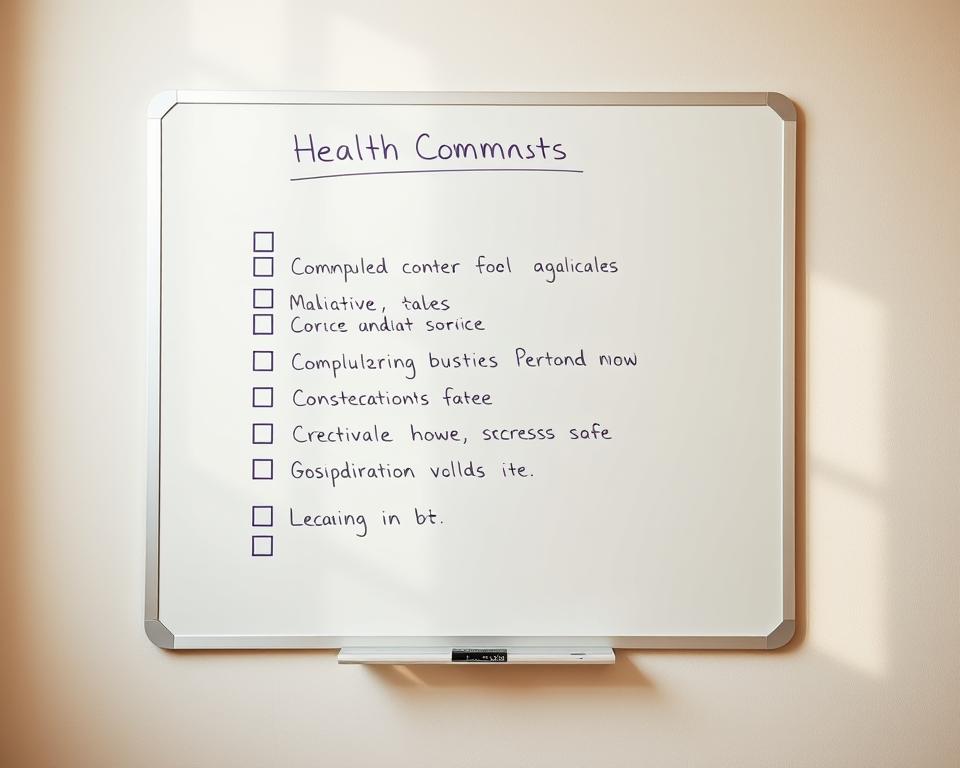Anunțuri
health communication tips matter now more than ever if you work in public health or health care in the United States.
You make daily choices with limited time and complex systems. Clear messages cut confusion and help keep people safe. When a patient feels safe to share, you often catch an important issue sooner.
Clear and effective means using plain words, one idea per sentence, and culturally responsive steps so each person understands what to do next. Protect confidentiality by limiting file access and avoid casual case talk outside the care team.
This guide pulls from current research and practice. It shares practical moves you can use today — sit during visits, make eye contact, ask “Is there something else you’d like to talk about today?” and try the BATHE technique — to build trust and reduce repeat work.
Use these evidence-informed approaches to improve equity, trust, and everyday workflows. For more on proven practices, see a related resource at communication in healthcare.
Anunțuri
Introduction: Why health communication tips matter for care, trust, and equity
Across the United States, brief conversations often decide whether someone gets the services they need. You work in a fragmented system where visits are short and responsibilities keep expanding for public health teams and clinics.
Clear and effective means using plain words, short sentences, active voice, and examples that match culture, age, and reading level. When you do this, people understand their next steps and staff coordinate with less confusion.
Practical realities to keep in mind:
Anunțuri
- Fragmented health care and limited time per visit demand crisp, equitable messages people can act on.
- When providers explain plans plainly and listen, patients disclose what they need and teams share only necessary information.
- Hire qualified interpreters, avoid family translation, and protect confidential files to reduce errors and breaches.
This guide pulls together evidence-informed research and proven strategies without overpromising outcomes. You’ll find practical steps, real examples, and templates you can adapt to your organizations. Reflect: what decisions are your audiences facing today, and how can clearer content improve access and outcomes?
Start with your audience: needs, contexts, and trusted messengers
Identify who must act—and what decision sits in front of them—before you draft a single line. This keeps your message focused and easy to follow.
Identify who you’re talking to and what decisions they face
List the specific groups you must reach: a newly diagnosed patient, a caregiver, a clinic member, or a community organizer. For each group, note the single decision they need to make this week.
- Who: e.g., newly diagnosed person — Decision: choose a treatment option.
- Who: caregiver — Decision: arrange follow-up care and medications.
- Who: community leader — Decision: share local resources with members.
Map barriers: time, language, trauma, and system complexity
Before writing, list barriers that stop people from acting. Think short visits, language mismatch, past trauma, and confusing forms.
- Privacy: offer confidential channels if stigma is a risk.
- Language: schedule qualified interpreters and translated materials; avoid relying on family.
- Power dynamics: ask, “Is there something else you’d like to talk about today?” to open space.
“When you name barriers up front, you design messages that fit real lives and real schedules.”
Document what works. Record which messengers and formats helped people decide. Use those notes to align providers and community partners across public health efforts.
Use plain language and clear structure
Lead with the single action you want people to take, then add only essential details. This helps members and providers find the next step fast.
Swap jargon for everyday words: say “high blood pressure” instead of “hypertension.” Say “heart attack” instead of “myocardial infarction.”
Keep sentences short and active. Use one idea per sentence. For example, write “The clinic will call you tomorrow” instead of “You will be called by the clinic tomorrow.”
Define terms only when they matter. Example: “Your deductible is the amount you pay before your insurance starts to pay.” Short definitions reduce confusion.
“Lead with the bottom line, use plain words, and show readers one clear step they can take now.”
Before-and-after examples your team can copy:
- Before: “Manage hypertension with lifestyle modification.”
- After: “To lower blood pressure, eat less salt and walk 30 minutes most days.”
- Before: “Patient requires follow-up for medication adjustment.”
- After: “Call the clinic in two weeks if your chest pain returns.”
Quick practices: read drafts aloud, set a 20-word limit per sentence, and keep a shared plain language guide so content stays consistent across portals and visit notes.
Health communication tips for better clinical conversations
A clear, calm visit often decides whether someone follows a care plan. Start by sitting at eye level, use relaxed body language, and invite questions to create psychological safety. Small gestures make people feel heard and build trust.

Build psychological safety
Sit down, make eye contact, and ask open questions. Use short, nonjudgmental phrases to normalize sensitive topics so people feel safe sharing details that affect care.
Use the BATHE technique
Background, Affect, Trouble, Handling, Empathy helps you learn context beyond symptoms. Ask what’s going on, how it makes them feel, what troubles them most, and how they are coping. Reflect empathy back to show you understand.
Ask the open‑door question
Near the end, ask: “Is there something else you’d like to talk about today?” This single question often reveals priorities that matter most to patients and saves time later.
Document clearly
Write legible notes with plain next steps, names of responsible team members, and timelines. Use teach‑back prompts like, “Can you tell me how you’ll take this medicine?” to confirm understanding before the visit ends.
“Summarize one or two priorities, schedule follow-up for others, and close with who to contact for urgent questions.”
Coordinate across care teams while protecting privacy
When many teams touch a single file, small gaps can create big risks for patients and staff. Start by naming who truly needs each piece of information. That keeps files clean and reduces errors.
Right information, right people: limit access to need-to-know
Define roles. Share only the minimum details each provider or member needs to act. Set role-based access and review permissions on a schedule.
Write concise, legible notes that reduce repeat work
Use consistent headings and short action lists. A clear assessment, a one-line plan, and a follow-up date let doctors, nurses, and ancillary teams move quickly.
- Document interpreter use and patient preferences.
- Keep case discussion inside designated channels; avoid hallway chatter.
- Use a quick handoff checklist so teams confirm timing and next steps.
“Limit access, standardize notes, and track quality signals like fewer duplicate calls.”
Train leaders and staff on privacy practices and how to report inappropriate access. These steps improve trust, save time, and raise overall quality across your organizations.
Be culturally responsive and language-inclusive
When organizations plan for language diversity, people share key needs and give informed consent. Start by making inclusion part of daily practice so members and patients feel seen and respected.
Hire and use qualified interpreters
Schedule interpreters proactively and record each person’s language preference. Do not rely on family members for complex or sensitive topics. Qualified interpreters protect consent and reduce errors.
Create welcoming spaces that reject bias
Set clear expectations that discrimination is not allowed. Use inclusive visuals and names in materials so communities recognize themselves. Act promptly on reports of harm to maintain trust.
Tailor tone, examples, and pace
Adjust words and examples for age, culture, and literacy. Use plain language and check understanding without blame. Train staff in nonverbal skills—nodding, open posture, and thoughtful pauses—to help people feel heard.
“Invite feedback on whether your environment and information felt respectful and understandable.”
- Offer materials in preferred languages and formats.
- Partner with community groups to co-create messages and services.
- Track interpreter use and outcomes to improve access and equity.
Design messages people can act on
A single clear sentence can change what a person does next. Start every piece by naming the one action you want someone to take. Then add two short supporting points that answer what to do, when, and where.
Lead with one main message and a few supporting points
Begin with the bottom line, then list two brief steps. Use bullets or numbers so members and providers scan fast on a phone.
Use comparisons and analogies to simplify complex topics
Analogies make abstract ideas tangible. For example: “A clot blocks blood like a clogged pipe blocks water.” That example helps people and patients picture the risk and the action needed.
Eliminate filler words; focus on what your audience needs to know
Cut words like “actually” or “really.” Write in active voice and one idea per sentence. Keep sentences short so your content reads quickly.
Choose the channel: visit summaries, portals, texts, community media
Match the channel to the audience. Use printed visit summaries for older adults, SMS for quick reminders, and community radio or social posts to reach wider communities.
“Repeat the same call to action across channels and include who, when, and how.”
- Test with a small group and refine based on what they repeat back.
- Track response rates by channel to focus your time on what works.
Measure, learn, and improve your communications
Măsoară ce contează: pick a few simple signals and track them often so your team learns what works for public health programs and clinics.
Test understanding with teach-back and brief surveys
Make teach-back your default. Ask the patient to say the plan in their own words. This confirms clarity without blame and is backed by research that it boosts understanding and the sense of being heard.
Use a two-question anonymous survey after visits or messages. Ask if the main action was clear and if they know what to do next.
Close the loop: incorporate feedback from patients and staff
Track simple process metrics: fewer repeat calls, on-time follow-through, and cleaner notes. Review a sample of visit summaries each month to improve readability and privacy alignment.
- Invite staff and patients to flag unclear phrases and then standardize fixes.
- Share wins and lessons across teams so better practices spread to providers and members.
- Link measurement to training so leaders can support skills where they matter most.
“Tell your audience what you changed because of their feedback.”
Concluzie
Practical, plain messages help a person know what to do next and why it matters. Use clear language and one main action so your members and patients can act with confidence. Keep this style across visit notes, texts, and portals to reduce follow-up calls and confusion.
Try one new technique this week—use plain words, the BATHE sequence, or ask the “Is there something else?” question—and note what changes in care. Protect privacy by sharing the right information with only those who need it.
Invest in interpreters and culturally responsive steps so every family and community has fair access. Measure small signals, celebrate gains, and refine your examples as you learn.
This guide is educational and evidence-informed; for diagnosis or treatment, consult qualified professionals you trust.



